
The Commonwealth Building is a 14-story, 194 ft (59 m) commercial office tower in Portland, Oregon, United States. Located at 421 SW 6th Avenue between Washington and Harvey Milk Streets, it was designed by architect Pietro Belluschi and built between 1944 and 1948. The building was originally known as the Equitable Building and is noted as one of the first glass box towers ever built, pioneering many modern features and predating the more famous Lever House in New York City.

The Sovereign Hotel was a Portland, Oregon, hotel built in 1923. The nine-story building was added to the United States' National Register of Historic Places on December 2, 1981. Part of the building houses a portion of the Oregon Historical Society's Oregon History Center.
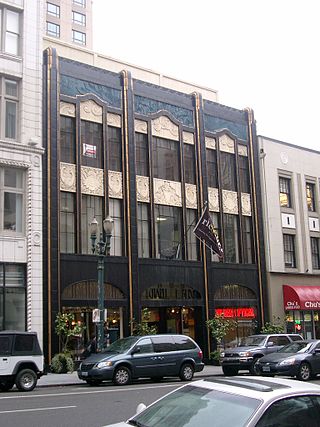
The Charles F. Berg Building, also the Dolph Building is an art-deco building in downtown Portland, Oregon. It is one of the few examples of commercial use of art-deco in Portland.

The Ladd Carriage House is a building in downtown Portland, Oregon, at Broadway and Columbia. It is one of the few surviving buildings forming part of the former grand estates which once stood in the downtown core. It is listed on the National Register of Historic Places.

The Seward Hotel, also known as the Governor Hotel, is a historic hotel building in downtown Portland, Oregon, United States, that is listed on the National Register of Historic Places (NRHP). Built in 1909, it is one of two NRHP-listed buildings that make up the Sentinel Hotel, the other being the 1923-built Elks Temple. The Seward was renamed the Governor Hotel in 1931, closed in the mid-1980s, and reopened in 1992 joined with the former Elks building, and thereafter formed the east wing of a two-building hotel.

The Yeon Building is a historic 59.13 m (194.0 ft), 15-story office building completed in 1911 in downtown Portland, Oregon. Almost completely clad in glazed terra-cotta, and culminating in a colonnade on the top floors, the Yeon Building once was illuminated at night by light sockets built into the cornices, but later removed. The building's namesake is Jean Baptiste Yeon (1865–1928), a self-made timber tycoon who financed the construction. At the time of completion, the Yeon Building was the tallest building in Oregon and it remained so for nearly two years.
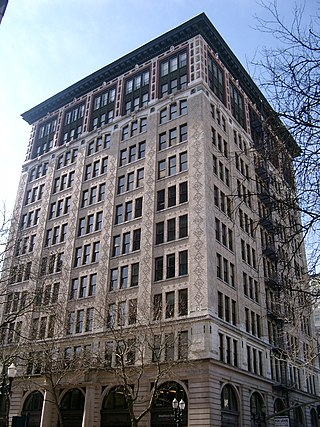
The Wells Fargo Building is a historic office building in downtown Portland, Oregon, United States. The large doorstep at the building's entryway required the largest slab of granite ever shipped to Portland at the time. Completed in 1907, the steel-framed building is considered the city's first true skyscraper. At 12 stories and with a height of 182 feet (55 m), it was the tallest building in Portland, exclusive of towers, and remained so for four years. The clock tower of the 1892-completed Oregonian Building, which measured 194 feet (59 m) in height, made that building the tallest in the city overall.

The Spalding Building, formerly the Oregon Bank Building, is a historic office building in downtown Portland, Oregon, United States on the northwest corner of SW 3rd Avenue and Washington streets. Since 1982, it has been on the National Register of Historic Places.
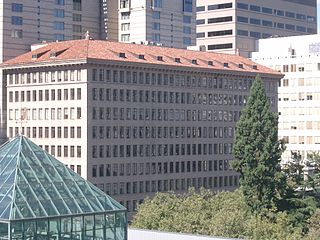
The Pacific Building is a historic office building in downtown Portland, Oregon, United States. It has been listed on the National Register of Historic Places since March 5, 1992.

The Public Service Building is a historic 67.06 m (220.0 ft), 15-story office building in downtown Portland, Oregon, United States. The building and its attached parking garage have been listed on the National Register of Historic Places as the Public Service Building and Garage since 1996. It was built to house the offices of the Portland Gas and Coke Company and the Pacific Power and Light Company. The building's name reflects the fact that these utilities were "public services". A space in the Public Service Building fronting the corner of Salmon and Sixth streets became the first Niketown store.
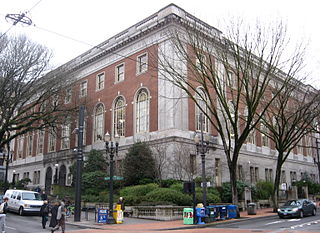
The Central Library is a three-story public library branch in the downtown core of Portland, Oregon, United States. Opened in 1913, it serves as the main branch of the Multnomah County Library system. In 1979, the Georgian style building was added to the National Register of Historic Places as the Central Building, Public Library. The library underwent major structural and interior renovations in the mid 1990s. The library also underwent a refresh in 2023.

Morris Homans Whitehouse was an American architect whose work included the design of the Gus Solomon United States Courthouse in Portland, Oregon.
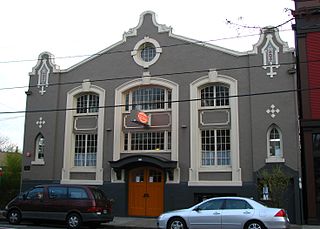
The Wonder Ballroom is a music venue located in northeast Portland, Oregon. Prior to opening in 2004, the building was occupied by the Ancient Order of Hibernians, the Catholic Youth Organization, the Portland Boxing School, the American Legion organization, and a community center eventually known as the Collins Center. In 2005, the building was listed on the National Register of Historic Places as the Hibernian Hall for its "historic and architectural significance".
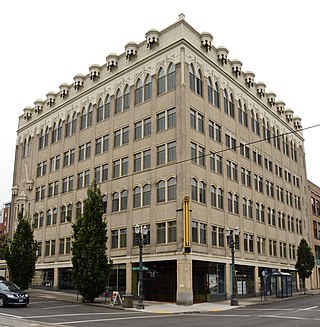
The Odd Fellows Building in downtown Portland, Oregon, was built in 1922–1924. It served historically as a clubhouse. It was listed on the National Register of Historic Places in 1980 for its architecture, which is Late Gothic Revival.

The First National Bank Building is a building located in downtown Portland, Oregon, listed on the National Register of Historic Places.
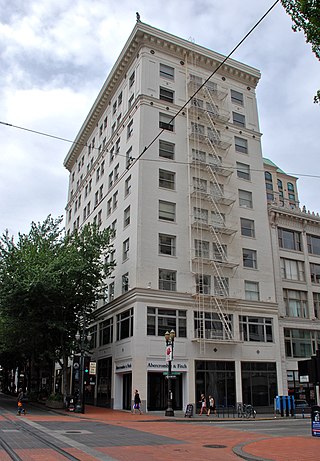
The Broadway Building, also known as the Pioneer Park Building, is a building located in downtown Portland, Oregon, that is listed on the National Register of Historic Places.

The Calumet Hotel, also known as the Esquire Hotel, is a former hotel building located in downtown Portland, Oregon, that is listed on the National Register of Historic Places. The building was changed from a commercial hotel to a residential hotel for low-income residents in the 1930s. At some point, it took the name Esquire Hotel. By the time of its nomination to the National Register, in 1983, it was vacant. The building was renovated in 2008–09 and is now known as "The Esquire" apartments.

The Corbett Brothers Auto Storage Garage is a building located in downtown Portland, Oregon, listed on the National Register of Historic Places.

The Postal Building is a building located in downtown Portland, Oregon, that is listed on the National Register of Historic Places. Designed by Whidden & Lewis, it was built in 1900 and is notable for its ornate terra cotta ornament.

The Selling Building, also known as the Oregon National Building, is a building located in downtown Portland, Oregon, listed on the National Register of Historic Places. It was built in 1910 for Ben Selling & Associates, composed of Ben Selling and partners Charles Moore and Moses Blum.























